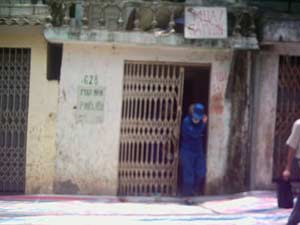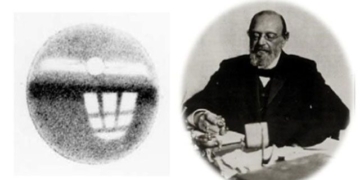In the house contaminated with radiation, the radiation dose is only 0.4 Micro Sievert, which is about twice the normal background level. Outside the sidewalk and the roadway, the radiation levels in the environment are nearly normal, according to Mr. Ngo Dang Nhan, Director of the Department of Radiation Safety and Control, reported on June 6.
 |
The contaminated house is gradually returning to normal, as technicians are decontaminating it to restore it to a livable state. Photo Ngoc Huyen. |
On May 26, the Rare Isotope Institute lost a container of chemicals containing the radioactive isotope Eu-152, a white powder weighing 54.8 milligrams, stored in a quartz ampoule, covered with a protective layer of lead, and placed inside a tin box measuring 12 cm in diameter and 15 cm in height. The current radioactivity of this substance is 14 millicuries.
According to an expert from the Department of Radiation Safety and Control, this radioactive isotope is used as a marker in rare earth research. This isotope was produced at the Dalat Nuclear Reactor in 1995.
Timely Detection…
At 10:30 AM on May 31, after the radioactive container was stolen, the Rare Isotope Institute coordinated with Police A17 to identify the thief and locate where the box was hidden.
Previously, during a renovation of the warehouse at the Rare Isotope Institute, a worker stole this tin box and sold it to a scrap dealer from Nam Dinh, who is currently residing at 628 Bạch Đằng Street, Hanoi.
The tin box weighed 7 kg and was sold for… 25,000 VND!
Eu-152 Emits Gamma Rays |
Europium was discovered by chemist Carl Mosander in 1843. It is a soft, silvery metal and the most reactive element among the rare earth elements. It rarely exists in free form and is mostly found in compounds. It is estimated that there are about 150,000 tons of Europium in nature, primarily concentrated in large mining areas in China and the United States. |
After purchasing the item, the scrap dealer immediately… smashed the box into scrap metal for resale! However, when breaking it open, the box split into two parts, revealing three internal latches along with some white powder that fell to the floor. The outer metal casing was dislodged, exposing a beautiful layer of black metal.
The scrap dealer tested it with a magnet but found no reaction. Assuming it was copper (a valuable metal), he decided to keep it and only sold the box’s outer casing.
When the incident was discovered, everyone was shocked… It was radioactive material, and it could emit radiation that affects people’s health.
Rapid Intervention and Thorough Decontamination
On June 5, the Vietnam Atomic Energy Institute took Ms. Hoa (the scrap buyer) and her entire family for health checks at the Military Medical and Tumor Institute – Military Medical Department. According to the Military Medical and Tumor Institute’s conclusion, no health impacts have been detected in Ms. Hoa’s family so far. However, the Institute will continue to monitor the health status of Ms. Hoa’s family.
According to Mr. Ngo Dang Nhan, the maximum dose that Ms. Hoa was exposed to was 5 mSv (Milli Sievert – unit of radiation dose).
In the event that Ms. Hoa stayed 24 hours continuously over five days from May 26 to May 30, this radiation exposure level would still be acceptable according to Vietnamese standards TCVN 6866:2001 for the population in the area.
Immediately after the incident was discovered, technical units proceeded with decontamination and isolation of the house at 628 Bạch Đằng, collecting all radioactive items and excavating all contaminated soil to be sent to the radioactive waste storage facility of the Rare Isotope Institute. Only technical staff were allowed to enter and were required to wear protective clothing and masks as per regulations.
Simultaneously, technical staff checked radiation levels in two adjacent houses (numbers 626 and 630). The results indicated that the two houses showed no signs of contamination.
By 11 AM on June 5, the entire area outside the street and sidewalk had returned to normal. Inside house 628, the environment was also gradually normalizing. The radiation level was reduced to 0.4 mSv (Micro Sievert – unit of radiation dose), which is about twice the normal radiation level under standard conditions.
Disciplinary Actions for Radiation Loss
On June 5, the Department of Radiation Safety and Control sent an explanatory document to the local government where the contaminated house is located to clarify the incident and its impact.
Mr. Ngo Dang Nhan, Director of the Department of Radiation Safety and Control, stated that the stolen radioactive source was of low intensity and small mass, so the level of harm was not too serious.
However, Mr. Nhan noted that the recent radioactive source theft incident caused public panic and impacted international integration relations. Worldwide, there is a trend of enhancing security for radioactive sources to prevent terrorists from using them to create dirty bombs. Therefore, the supervisory agency will decisively impose strict penalties on the units and individuals responsible for the radioactive source loss that caused unfortunate consequences.
According to an expert from the Department of Radiation Safety and Control, the Rare Isotope Institute, the unit responsible for the loss of radioactive material will bear all costs for repairing the house and compensating for the contaminated items in Ms. Hoa’s home.
In the coming days, disciplinary results will be announced regarding some officials responsible for managing this radioactive source.
Ngoc Huyen




















































